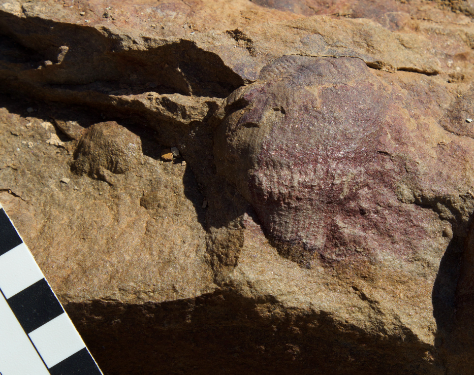 Evolution & Behaviour
Evolution & Behaviour
Life’s early dinner parties
Ernietta was a complex lifeform inhabiting the Earth’s earliest seafloor ecosystem. There are few fossil specimens available to study in detail how these organisms fed. However, thanks to virtual fluid studies, we have been able to demonstrate that Ernietta was feeding on suspensions and assembling in groups. Thus, our results provide a link between today’s oceans and the earliest ecosystems.

Ediacaran life is represented by a group of bizarre-looking fossils that are the remnants of the first complex life in Earth's oceans from over half a billion years ago. During this time, life was sessile and tranquil, with few traces of large-scale predation and movement. Because of their unique body shapes and bizarre features, scientists have struggled for 100 years to place them on a tree of life. One particularly enigmatic fossil of the Ediacara biota resides in southern Namibia, often weathering out of sandstones. These fossils are the last remnants of Ernietta - a round, vase-shaped fossil constructed out of repeated cylindrical elements that suture together at the base of the "vase". Understanding how this organism may have lived has been difficult without a physical feature that we may recognize in animals today. Further adding to this mystery is that we see small accumulations of these fossils all oriented in life position, where each individual has the lower-most portions of their "vase" buried within the sediment, creating a sediment trap within the cavity of the vase. To make matters even more complicated, this buried portion of the organism is the only portion that is preserved except less than five complete specimens that are currently known.
To better understand this organism, we conducted a series of experiments to determine how it could have been feeding and why they lived groups. Because of so few complete specimens, we built a digital model of the organism. We then used it to assess how the morphology of Ernietta may have affected fluid flow over the organism to determine how they fed.
Because the ocean floor was so tranquil during this time, two feeding ecologies are frequently proposed for Ediacaran animals, osmotrophy, and suspension-feeding. Osmotrophy is an efficient feeding strategy for organisms with very high surface area exposed to fluid and lower amounts of total body volume. With flow evenly dispersing across such high surface area, dissolved nutrients within the surrounding water can efficiently be absorbed into the body. Suspension feeding is more efficient for larger nutrient particles to be absorbed. It is often characterized by nutrient-rich fluid directed to specific anatomical regions where they can be absorbed. We then ran computational fluid dynamics simulations, whereby we placed our model in a digital fluid flume tank and allow water currents to flow over the model. By analyzing flow patterns over the surface of the model, we assessed how the overall shape of Ernietta affected fluid flow around it. Because we do not know to what extent it was buried, we adjusted the amount of the organism that was above the sediment and thus exposed to flow. Regardless of water velocity or burial depth, fluid flow followed the same pattern. Upstream water was directed into the cavity of the organism, where it always recirculated and then caused additional eddies downstream of the organism. The consistent direction of fluid flow into the cavity of the organism demonstrated that this was likely the location of feeding, and the low surface area of the organism further supported a suspension-feeding interpretation.
While these results answered how Ernietta fed at the bottom of these ancient oceans, they did not provide information for why they were aggregating in patches. These aggregations could have been a byproduct of reproduction where younger individuals were recruited nearby the parent, or they equally could have been a product of another process. To answer this question, we repeated our experiments using small groups of individuals. Regardless of spacing or arrangement of individuals, fluid recirculated in all cavities. Downstream, Ernietta received enhanced recirculation from the eddies created by the upstream. These organisms were likely clustering to aid in feeding. We see direct evidence of this commensalism in modern ocean ecosystems, where one organism is able to gain benefit from another that is left unaffected. This organization is harder to observe directly in the fossil record, and these organisms displaying this behavior sheds light on how far back in the geologic record this behavior has existed. Their commensal, gregarious nature represents one of the oldest examples of this behavior in the fossil record, further demonstrating that even though these enigmatic animals look very different from today's life, they are more similar than previously thought.
Original Article:
Gibson B, Rahman I, Maloney K et al. Gregarious suspension feeding in a modular Ediacaran organism. Sci Adv. 2019;5(6):eaaw0260.Next read: Snake uses its split jaws as a knife and fork by Yosuke Kojima
Edited by:
Massimo Caine , Founder and Director
We thought you might like
More from Evolution & Behaviour
Cicada emergence alters forest food webs
Jan 31, 2025 in Evolution & Behaviour | 3.5 min read by Martha Weiss , John LillSize does not matter: direct estimations of mutation rates in baleen whales
Jan 29, 2025 in Evolution & Behaviour | 4 min read by Marcos Suárez-MenéndezThe Claws and the Spear: New Evidence of Neanderthal-Cave Lion Interactions
Jan 22, 2025 in Evolution & Behaviour | 3.5 min read by Gabriele RussoA deep-sea spa: the key to the pearl octopus’ success
Jan 20, 2025 in Evolution & Behaviour | 3.5 min read by Jim BarryFeisty fish and birds with attitude: Why does evolution not lead to identical individuals?
Aug 31, 2024 in Evolution & Behaviour | 3 min read by Lukas Eigentler , Klaus Reinhold , David KikuchiEditor's picks
Trending now
Popular topics


